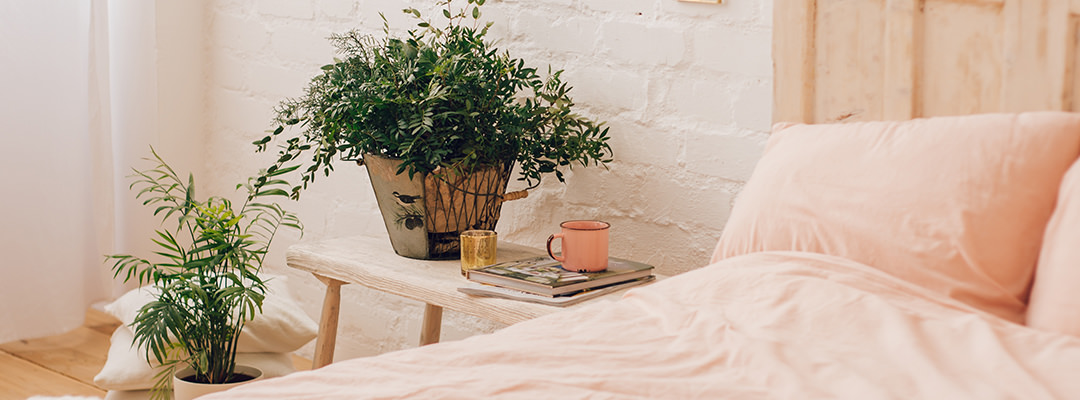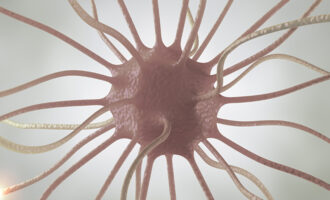We all know that when it comes to our best sleep life, a safe, peaceful, happy bedroom area can be game-changing. Creating a space where you can leave your day-to-day worries aside and prioritize your body and mind can be the key to conquering anxiety-induced sleep disorders and improving your health overall. And it turns out, one of the greatest ways to do that is by using plants in your sleep space.
Plants are basically powerhouses when it comes to taking care of our physical, emotional, and spiritual well-being. In addition to giving your bedroom some much-needed life and color, several plants have a slew of sleep-positive effects like air purification, sedative properties, and stress relief. Let’s look at how sleep-inducing plants can elevate your bedroom and help you get the sleep that you need.
Benefits of sleep-inducing plants
Keeping indoor plants in your house has been proven to have a positive effect on stress relief and on mental health. It’s no secret that human beings have always been drawn to the natural world, and bringing little pockets of the natural world into your sleep space could be the key to a better night’s sleep.
If that’s not enough, keeping plants around can offer some practical benefits including purifying the air you breathe, emitting sedative odors, and absorbing noise from the street or other apartments. All of this contributes to a better, healthier night’s sleep, which will do nothing but good for other aspects of your waking life, too.
How do you take care of sleep-inducing plants?
Just like people, every plant’s needs are different, so it’s recommended that you start with just one or two plants and get to know them before incorporating more. Most plants enjoy bright sunlight, so a well-lit windowsill is a good idea (plus, then they work as sound barriers against the outside world). Your garden center will be able to tell you whether your plant prefers full sunlight, partial light, or shade.
Another thing plants love is water! But again, every plant’s need is different. Instead of watering them on a set schedule, try to get to know them and look for clues that tell you your plant baby is thirsty. Begin with the idea that less is more — twice a week is a good starting place. Then look for leaves that are beginning to dry around the edges or lose their color, and feel the soil beneath to see if it feels dry or if it still has some moisture in it from its last watering. As you become more familiar with your plant, picking up on what they need from you will become second nature.
Our 10 favorite plants for better sleep
Easy, lovable, and super beneficial for sleep and waking health alike. Let’s look at ten of the best plants you can keep by your bedside for a better night’s sleep.
Lavender
One of the most celebrated flowers in contemporary herbalism, lavender is proven to reduce anxiety levels and lower blood pressure. It’s also been used to induce deeper sleep in babies and new parents! Lavender is a sun-loving plant, so a sunny windowsill is the best place for it. You can also hang dried lavender above your bed or put it in a sleep sachet to keep under your pillow (make sure the flowers are dried completely though, elsewise they can start to mold!).
Jasmine
Another relaxation-inducing plant, jasmine has long been associated with the perfumery industry. Jasmine is indolic, which means its scent has traits in common with the natural scents of the human body. It has been shown to encourage more restful sleep, as well as encouraging higher cognitive performance during the day. Jasmine is a plant that likes partial sunlight and cooler temperatures.
Aloe Vera
Known as one of the great healing plants, aloe is an easy-care plant to have in your sleeping space. Unlike most plants, which produce oxygen only during the day, aloe produces oxygen during the night too. It’s known for its air-purification properties, plus it’s a great one to have on hand for small burns, cuts, and dry skin. Aloe loves bright, warm places, but as a succulent, it needs watering very rarely.
Snake Plant
This is another plant known for producing oxygen at night. It’s used by NASA as an air purifier, known for removing harmful chemicals from the air, including ones used in cosmetic and body problems. Snake plants are low-maintenance, preferring partial sunlight and low water levels.
Spider Plant
Spider plant is another one known for absorbing harmful toxins from the air. In fact, it’s been shown to eliminate 90% of the formaldehyde in the air surrounding them (which can come from body products like perfume and hairspray) as well as many unpleasant lingering odours. They’re also super low-maintenance, requiring little sunlight and water.
Ivy
English ivy is another powerhouse air purifier, known to reduce the presence of toxins, allergens, and airborne mould in the air. It looks beautiful and is a great choice for allergy sufferers or people with asthma. However, it is toxic if ingested, so it’s best to keep it out of reach of children and pets; a basket hanging in the window is a good choice.
Valerian
Valerian has a proud history as a sleep herb, and has been shown to induce relaxation and lower stress levels simply by inhaling the scent — simply breathing in the smell will encourage deeper sleep. It’s used as a common treatment for insomnia and anxiety. You can also use the dried flowers as a sleep aid. This plant thrives best in bright sunlight, so a full sun window is the best place for it.
Golden Pothos
Golden pothos is a member of the ivy family and another great choice for hanging baskets. This is another plant that’s been studied by NASA for its air-purification properties, known for removing formaldehyde and carbon monoxide from the air. They’re a great choice for busy people because they’re low-maintenance and require only partial light and occasional watering.
Peace Lily
Peace lilies help purify the air and work to balance humidity in particularly dry environments. This helps to ease skin irritation, static electricity, and susceptibility to illness. They create an easier breathing environment and remove certain toxins from the air. They prefer shaded environments, so they’re a good choice for apartment dwellers who don’t get a lot of sun.
Gardenia
Gardenia is a celebrated flower known for its calming, stress-relieving properties. They’ve been shown to have strong sedative properties just from inhaling the scent, and can induce a deeper, more peaceful sleep. Many people like to keep them near their beds as a natural alternative to pharmaceutical sleep aids. Gardenia flowers prefer lots of sun and a moist environment.
Try plants and flowers for a natural sleep aid
Whether you live in a house with a sprawling garden or in a tiny studio flat in the heart of the city, plant life can elevate your well-being in surprising ways. Next time you have trouble sleeping, try getting to know one or more of these sleep-inducing plants; a little low-key rewilding may be just what your body needs.
Did you like it?4.6/5 (26)





